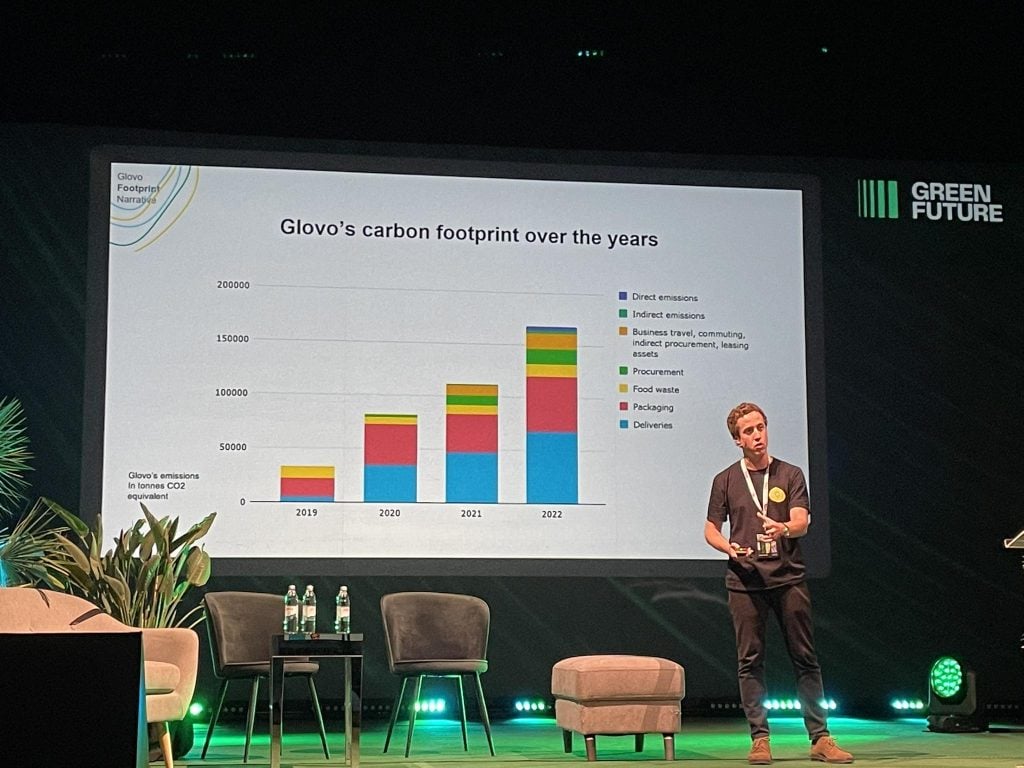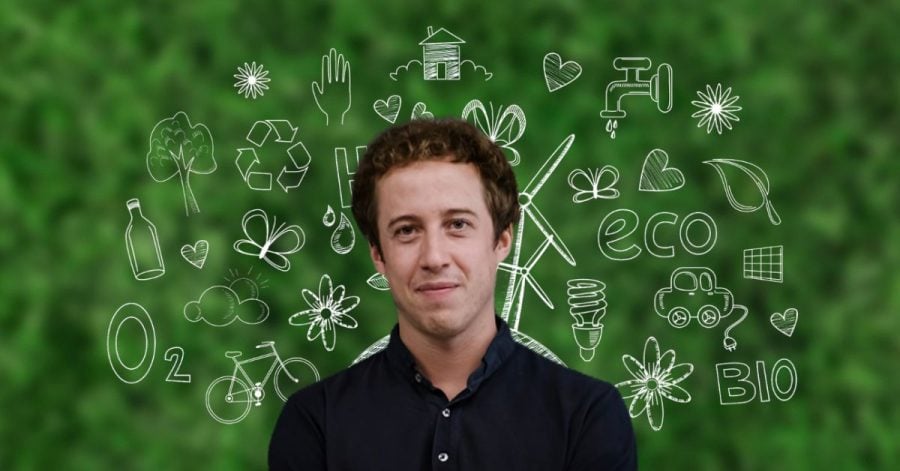In an era marked by increasing concern for the environment and social responsibility, companies worldwide are embracing sustainable practices to ensure a positive impact on society. Global delivery service Glovo is one of them – the company, which started out as a small delivery service in Barcelona, is now present in more than 25 countries and is constantly looking to expand. In 2021 the company managed to raise the biggest funding round in the Spanish digital sector, amounting to €450M, and became a unicorn.
However, such growth also brings a number of challenges, especially when it comes to sustainability and the rising carbon footprint as a consequence of the company’s delivery activities.
One of the people leading the company’s charge toward sustainability is Sébastien Pellion, the company’s head of social Impact and sustainability.
With a license in Public Policy from SciencesPo in France or the University of Ottawa in Canada, Pellion brings a wealth of expertise in sustainable development and impact to his role at Glovo. He aims to align the company’s mission with ambitious sustainability goals, ensuring that Glovo’s growth is both profitable and beneficial to society at large, and achieves a sustainable delivery service.
Recently, at the Green Future Conference in Split, Pellion took center stage to share insights into Glovo’s plans to achieve its ambitious sustainability goals.
What are Glovo’s main mission and vision?
Sebastien Pellion: Our vision is to give everyone easy access to anything in their city. And how are we doing that – globally we build a digital marketplace, which is connecting thousands of couriers that are delivering products to your home with thousands of partners – supermarkets, restaurants, shops, retailers, that collaborate with us and sell their products through Glovo, and our customers.
And today, we have about 20 million active customers in the world, and we can deliver anything – your clothes, food, groceries, pharmacy. In some countries, customers are even using Glovo to donate to NGOs through the app.
So we have the ambition to become a super app, and today we are present in 25 countries. There is Southwest Europe, the Balkans, Eastern Europe, and Africa – we’re developing now pretty fast in a few African countries.
How do businesses assess the impact that they have when it comes to sustainability?
If you want to build impact into the core, the first thing you need to do is analyze actually what are your impacts. And any business should be aware of that and take ownership of both the negative and positive impacts. So at Glovo, we’re generating a negative impact: single-use packaging that’s very specific to delivery, you cannot deliver without packaging.
Then we also influence diets, people choose their food on the app and sometimes influence meat-based diets, which can be unhealthy for example. Then, there is also food waste, and we generate food waste in our operations. Then there are also the one combustion vehicles, we have a fleet of couriers and in most countries, they use combustion vehicles.
But on the other side, there is a positive impact. First, there is the convenience to do business, and we are able to deliver anything to everyone. And we give extra time to very busy citizens, so it means time savings and less stress in the day-to-day. We’ve become a major digitalization tool for small local businesses. We’re also giving continuity to essential services in times of crisis, and we’ve seen that during the COVID-19 pandemic because Glovo kept operating during the pandemic, and also now we’ve kept operating in Ukraine.
And then Glovo is also an opportunity to give access to work and income. So now we have a series of impact commitments on how to maximize the positive impact of operations and minimize the negative impact, and this is based on three pillars.
What are these pillars and how do they work?
The first one is to leverage technology and help NGOs receive donations. And we do that in two ways – the first one is through free logistics such as free deliveries, while the second one is by giving access to NGOs to fundraise in the app.
The second pillar of the impact strategy is growth. So here we’re setting new standards to make our ecosystem grow. So when I say our ecosystem, here I mean our partners, couriers, and communities. We also do this through other initiatives, like for instance, the courier pledge, which is a commitment to improve working conditions for couriers.
Then we have the Glovo local, which is our umbrella program to support the use of small local businesses by giving them more visibility in the app. There is also the women in tech initiative, that’s also a key area for us to reduce the gender gap because in regard to the tech sector.
And the last pillar is to reduce the environmental footprint across our operations and our ecosystem. The carbon footprint of Glovo over the last years is not looking great. Over the last four years, we went from being a small startup to a multinational, operating in 25 countries, and this largely explains the gross carbon emissions.
What is Glovo doing to offset this carbon footprint?
There are three main sources of emissions – our transportation, the emissions from the vehicles that are used by the couriers, and the packaging because the packaging is also CO2 emissions and food waste.

On the other side, our stakeholders are more and more interested in sustainability and concerned about what Glovo is doing to reduce environmental impact. So we were running surveys regularly for partners to our customers to understand what they are concerned about and how we can act. Many of our partners are already using sustainable packaging in their operations, and many are offering plant-based options in their menus.
And on the consumer side, 80% of our customers are eager to repeat their orders if it comes in sustainable packaging, and 14% are interested in having their orders delivered in non-combustion vehicles. So to respond to these expectations, since last year Glovo is carbon neutral across its entire value chain – so not just operations, but also regarding the emissions that we need upstream and downstream of our value chain.
The emissions of the restaurants, the grocery supermarkets, as well as for instance, the emissions from the food waste, which is generated by our customers at the end of the chain. So here we collaborate with different companies, and we buy carbon credits from them.
And there is one that we particularly like, called Pachama, which is actually a tech company that has developed a verification system to verify reforestation projects. They use LiDAR, which is a type of radar, to verify reforestation projects, and estimate the production potential of these projects.
But this is something that any company should be doing and we consider it as a must – so we need to be going a lot further with it. We have also set targets for 2030 – we actually added the objective to reduce our emissions by 42%. And how are we doing that – we have four operational targets.
The first one is to deliver 92% of orders with sustainable packaging. The second one is to deliver 10% of orders from food surplus, for instance, by donating food surplus to charities. The third one is to deliver 67% of our orders with non-combustion vehicles. And the last one is to bundle 30% of orders – this is when the same courier delivers several packages in the same route, so for instance, he’s going to pick up two packages in one restaurant, and then deliver them to two different customers.
What are the solutions that Glovo is looking at to achieve this feat?
We’re working on three main pillars. The first one is sustainable packaging. Just as a reminder, emissions from packaging are higher than emissions from aviation worldwide. So it’s a pretty big deal. What we are doing right now is that we are working on affordability. Because it’s pretty simple for a big partner, a big chain to change its packaging to something more sustainable, it’s a lot more difficult for small local businesses, because they’re very cost sensitive. So changing their packaging to sustainable packaging means attempting operations that are difficult to tackle.
What we’ve done is build a global e-commerce store, where we actually sell sustainable packaging to small local businesses at a very affordable price. We use it as an incentive for them to buy packaging.
The second aspect we’re working on in terms of packaging is awareness – giving more awareness to our customers about the partners that are buying sustainable packaging. So we actually created a space in the app where our customers can order just exclusively from restaurants that are using sustainable packaging. So that way, we’re getting more visibility, and we’re generating more traction.
And if it’s good for the business and it is progressing, they are going to change their habits and start using green packaging. So it works as an incentive for more restaurants and more supermarkets to change their habits. And the last thing that we’re working on is to reduce plastic – what we did very early was create a feature in the app to enable customers to opt out of cutlery.
Food waste is the second angle that we’re working on. So here, what we’re doing to reduce food waste is to identify short-dated products and we’ve got a discount on them to sell them faster to avoid generating any waste. And we’re doing that mostly in our groceries business, which is about 2.5% of revenues that we can potentially lose on a yearly basis due to food waste.
Then, there is the fleet electrification, which is a big challenge for us. We have around 70 thousand couriers, and today just one out of 250 cars globally is electric, so there’s a lot of progress to be done here.
We negotiate deals with providers of electric vehicles and give such incentives. Another thing we’re working on is working together with our supply chain because, in most of our countries, we’re working with third-party logistics partners, like for instance in Croatia. So we go co-invest with them, to incentivize them to change their fleet to 100% electric.
There is definitely an evolution in the distribution of vehicles in the fleet in Croatia over the last 18 months. You can see the share of electric motorbikes evolving very fast over the 18 months. So we’ve started from less than 25% of sustainable vehicles in the fleet to more than 50%.
Actually, Croatia is a pioneering country across 25 markets in terms of electric motorbikes. And this is due to the fact that one of our major third-party logistics partners is investing heavily in electric vehicles, and we are co-investing with them in changing the fleet.
Which one of these trends is most likely to affect the delivery industry in a positive way?
I believe electrification of the fleet is probably the main challenge that we need to tackle with more priority since it takes 45% of our carbon footprint space and is a major source of emissions. And if we don’t do anything, it’s going to affect more and more regulations in different countries, such as prohibiting combustion vehicles in some areas and cities.
So in some cities, we can’t actually operate without them and they are becoming a major topic for the operations team because we need to find solutions. I think this is going to be also the most challenging, because today, electric vehicles, even though we incentivize them, are getting more expensive.
But then again this is the same as with renewable energy – at the beginning, there were a lot of incremental costs, but now it’s normalizing, and I think that the same will be the case with electric vehicles as well.








